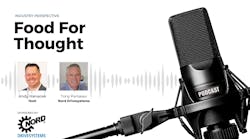The Industrial Internet of Things (IIoT) has taken hold of much of the manufacturing world, and food and beverage processors who haven’t yet implemented the technology will soon fall behind. The simple fact of the matter is, the wait for IIoT to reach this industry is over — processors who begin to understand what the technology can do for their own process improvement will be in better shape the faster they move on implementation. We spoke with James Howe, executive vice president - chief commercial officer/chief technology officer for Motion, to learn where the food and beverage industry stands on IIoT implementation, what processors can do now to begin their journey down the path to IIoT success, and how to overcome the hesitance that might hinder more traditional operations.
Food Processing: How do your food and beverage customers use IIoT technology to their benefit?
James Howe: Motion’s customers include many global household brands for food and beverage companies, which use IIoT to monitor their processes and machine health. Machine health allows them to move from preventative or planned maintenance into a predictive maintenance zone. The technology produces a multitude of benefits for maintenance and production by allowing them to have an equipment health check and inform them of issues before failure. This gives the company more reliability on their equipment, ensures smooth production flow, and avoids high costs.
JH: My biggest takeaway is from the insights learned within the maintenance departments. We are experiencing a labor shortage across many industries in the U.S. today — maintenance and engineering are no exception. Most of our customers are challenged to find trained, qualified talent. IIoT’s impact on the maintenance departments and their staffing can be significant. It allows them to do informed maintenance on the machine’s health only when necessary, rather than on a regularly scheduled basis. This enables staff to focus on the issues at hand and eliminate unplanned downtime and emergencies so that they can focus on the most important task: keeping the equipment running and mitigating unplanned downtime.
FP: Let’s talk a bit about the technology and what it brings to the table. What is unique about the technology that processors should know about?
JH: What’s unique about Motion’s technology is our ability to aggregate. Motion is an industrial distributor, but we aggregate customer supply chains and do the same within IIoT. We assemble all the data from different sources into a plant floor layout, creating a digital version of the factory floor with real-time health statistics on their equipment.
While many manufacturers have proprietary monitoring software that predicts the health of many different pieces of rotating equipment, Motion’s technology is unique in that we assemble all of that on one layout instead of getting 15 different data sources and feeds for health alerts and text messages.
FP: How does Motion anticipate and leverage technological trends to create cost-saving solutions for these processors?
JH: We always anticipate and provide our customers with cost-saving solutions at Motion. These can be through innovative products, technology like IIoT or training. There are numerous cost-saving opportunities for customers to be more efficient with different processes in their facility. Documented cost savings is a commitment we make to many of our largest customers — we documented over $70 million worth of cost savings in 2022. Providing the preferred customer experience is part of the culture at Motion and part of the value we provide to the market.
FP: What would you say to those processors who maybe haven’t begun this journey, this digitization and IIoT journey; and if they have any fears, how can you allay those fears?
JH: Motion is not new to this game. We’ve been in preventative maintenance for about 10 years. It started with the steel, cement and aggregate and mining industries — large, very expensive assets that were critical to keep running. We’ve seen that migrate completely into the mainstream through the years. Some of our largest orders today are from food and beverage customers. But you can start with something very simple in a facility. There are many companies providing solutions today. I suggest asking your maintenance and engineering partner, who already provides value at your facility. If it’s Motion, great; if it’s another partner you have, that’s terrific, too.
Starting with a few applications to eliminate your biggest headaches is the next step. This could be simple, like monitoring data on-site in a plant facility that doesn’t allow data to leave the site. This will provide the best path forward to ensure your monitoring is aggregated in a dashboard.
FP: Is there any difference in adoption and implementation between large and small plants? What considerations should our listeners have if they’re a smaller facility or in charge of a big facility?
JH: We’ve had applications in both small and large facilities. Much of the interest today is with large companies, which have the most innovative technology targets. In quarterly business reviews with our large customers, including in the food and beverage industry, IIoT is the hot topic. There are also plenty of opportunities within small industries and facilities; the cost continues to decline, and the installation continues to simplify. The time is now for all customers within the food and beverage industry to investigate and look at opportunities within IIoT.



